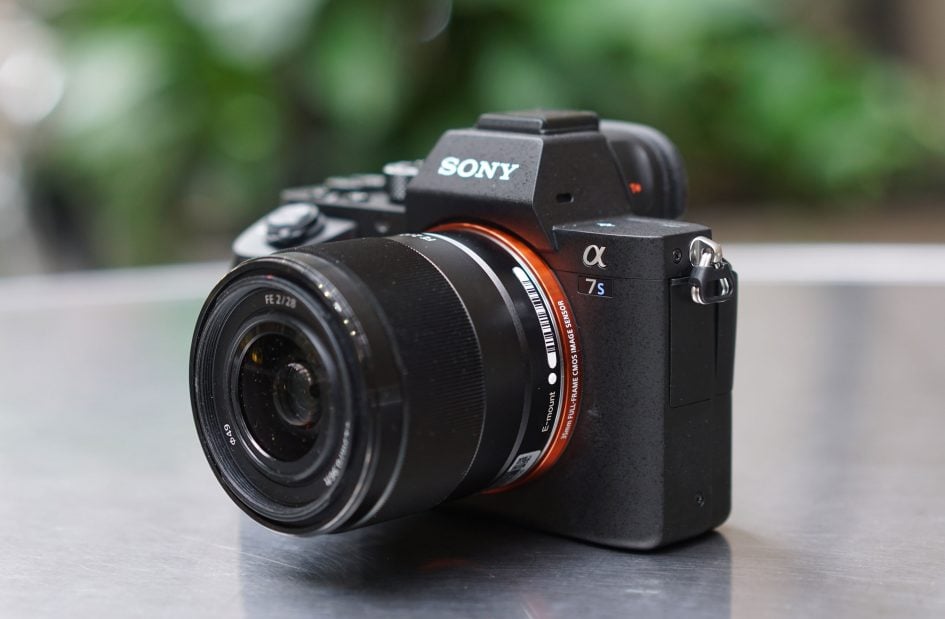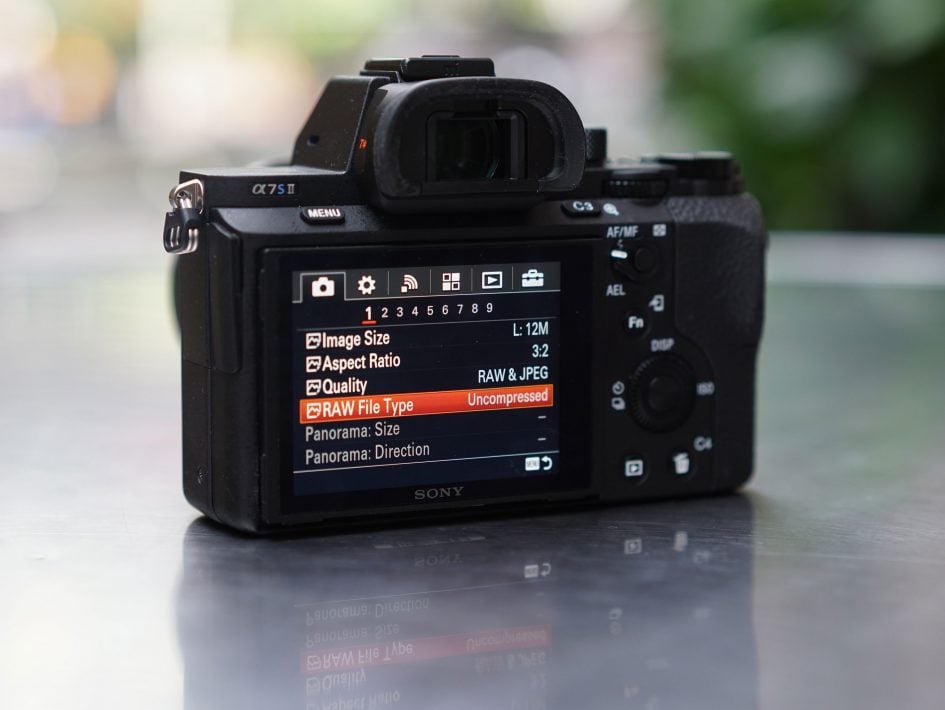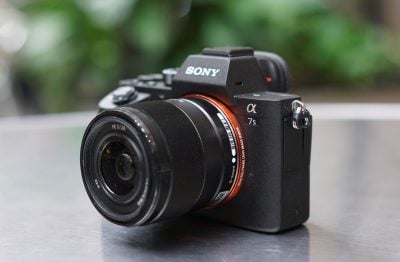Sony Alpha A7s Mark II review
-
-
Written by Gordon Laing
Verdict
Sony’s Alpha A7s Mark II is a full-frame mirrorless camera that’s optimized for 4k video, particularly in very low light. Sony’s essentially taken the 12 Megapixel sensor of the original A7s Mark I and slotted it into the body of the A7r Mark II. As such the sensor still delivers clean 4k video – and photos – at high ISOs, but now also enjoys the benefits of internal 4k recording, built-in stabilisation, an improved viewfinder, chunkier grip and repositioned controls. From the professional FS series the A7s Mark II inherits two new Picture Profiles for S-Log 3 and it also becomes the first A7 to enjoy support for uncompressed 14-bit RAW photos, although this is also being rolled out to other models via firmware updates; indeed the A7r II has already received its update.
In practice the A7s Mark II delivers virtually noise-free 4k footage up to 6400 ISO and only suffers from a very mild sprinkling of noise up to 25600 ISO. Beyond here the noise artefacts steadily increase, but footage remains pretty usable up to 102400 ISO. Meanwhile the maximum sensitivities up to 409600 ISO may become very noisy, but they do allow you to film under ridiculously low light levels, the novelty and flexibility of which makes up in some part for the loss of quality.
The ability to record 4k in-camera is a big upgrade over the original Mark I, as are the built-in stabilisation, improved viewfinder and better thought-out ergonomics. Meanwhile the addition of S-Log3 on Picture Profiles 8 and 9 deliver a higher dynamic range than before and give plenty of opportunity for grading.

In the original triplet of Mark I A7 cameras, there was no question the A7s was the preferred choice for film-makers and subsequently there’s a natural assumption that’s still the case with the latest Mark II models. However with the A7r Mark II, Sony created a camera that’s more than just about high resolution stills. It too can capture 4k movies internally with surprisingly good quality, while the massive pixel count gives it the flexibility of shooting 4k with an APSC crop too. And lest we forget, the A7r Mark II shares the same body, viewfinder, screen, controls and stabilisation as the A7s Mark II, and both cameras are in a similar ballpark price-wise.
So which should you get? The choice is actually less obvious than you might think and boils-down to some pretty specific conditions where one edges ahead of the other. First let’s look at still photos as that’s easy. In terms of resolution and detail there’s no contest – obviously the 42 Megapixels of the A7r Mark II considerably out-resolve the 12 of the A7s Mark II, and you can see this clearly illustrated in my quality page.
Increase the sensitivity and you might expect the A7s II with its fatter pixels to enjoy a lead on noise levels, but Sony’s actually done such a good job on the A7r II sensor that when viewed at 1:1, the A7s II only begins to takes a lead above 6400 ISO. Downscale the A7r II images to the same 12 Megapixel resolution as the A7s II and they’ll look pretty similar up to 51200 ISO. So you’ll only enjoy a noise advantage for still photos on the A7s II if you shoot at extremely high ISOs. As such I’m giving an overall win to the A7r II for still photos.
In terms of autofocus, the A7s II is contrast-based only whereas the A7r II enjoys the benefit of embedded phase-detect AF in a central region. In good light the A7r II focuses faster and the PDAF allows effective tracking of moving subjects at the top speed of 5fps, whereas the A7s II needs to slow down to around 2fps to track anything in motion.
That’s not the whole story though. As light levels fall, their Single AF speed becomes similar and in extremely low light the A7s II will continue to focus after the A7r II gives up – but we’re talking virtual darkness at this point. So unless you shoot in very dark situations, I’d say the A7r II autofocus is preferable overall and don’t forget the PDAF can also be deployed while filming video.
Which brings us to movies. As you know already the A7s II only films 4k with the full frame, whereas the A7r II allows you to film 4k with the full-frame or an APSC / Super-35 crop. All three options involve some scaling, even the A7s Mark II.
In terms of resolving power, the full-frame mode of the A7r Mark II is respectable but lacks the bite of its APSC mode. The interesting thing though is the A7r II filming 4k in APSC looks very similar to the A7s II filming 4k in full-frame; indeed the former actually looks a tad sharper, although this could be down to processing.
Above: Sony A7s II vs Sony A7r II (APSC) vs Sony A7r II (full-frame) – 4k daylight resolution at 100 ISO.
Start filming at higher ISOs and you’ll find the A7r Mark II 4k footage in either mode begins to show a sprinkling of noise from 1600 ISO, whereas the A7s Mark II remains entirely clean until 6400 ISO. Between 1600 and 25600 ISO the quality of the A7r II’s full-frame 4k deteriorates much faster than its APSC mode, confirming Sony’s suggestion to use this mode for the best results. Meanwhile the A7s II continues to enjoy a noise advantage of around two stops over the A7r II in its best-case scenario.
Above: Sony A7s II vs Sony A7r II (APSC) vs Sony A7r II (full-frame) – 4k low-light noise at 1600 to max ISO.
There’s several things to conclude from this. First is to be aware the A7r II’s full-frame 4k has limitations both in terms of ultimate detail and high ISO performance; indeed it’s dramatic how much worse it looks than the APSC mode between 6400 and 25600 ISO.
The second thing to conclude is the A7r II when filming 4k in its APSC mode is actually very close to the quality of the A7s II in its full-frame mode. The resolving power at low ISOs is essentially the same and you’ll only notice a noise advantage from the A7s II above 1600 ISO. Once again from this point onwards the A7s II enjoys around two stops better quality, but if you film at lower ISOs the main choice really boils down to which lenses you use.
The A7s Mark II can only film 4k with full-frame coverage, which means all lenses deliver an uncropped field-of-view. The A7r Mark II can also film 4k in full-frame but for the best quality it should be set to APSC / Super-35 at which point it’s applying a 1.5x field-reduction. This means if you like to film wide, you’ll need wider focal lengths to deliver the same field of view, but conversely if you film long, you’ll appreciate the tighter crop.
It’s also important to remember the APSC mode allows the A7r II to film 4k with cropped lenses or deploy Speed-Booster adapters with full-frame DSLR lenses to claw-back an extra stop of aperture. That extra stop effectively halves the high ISO advantage of the A7s II, bringing the two cameras even closer – so long as you can exploit the APSC crop to your advantage. And while I’m recommending the APSC mode for the best results, the full-frame quality on the A7r II isn’t bad, especially at low ISOs, allowing you to deploy full-frame coverage when desired.
Of course there are other benefits the A7s II has over the A7r II for film-makers including S-Log 3, a gamut preview and the ability to film between 25600 and 409600 ISO, but unless you frequently use these ultra-high sensitivities, for me the choice again mostly boils down to which lenses you’re going to use. If you want to use the coverage of full-frame lenses then the A7s II will out-perform the A7r II on 4k, especially at high ISOs, but if you can work with APSC then the A7r II delivers essentially the same quality up to 1600 ISO; and while the A7s II enjoys a two-stop noise advantage beyond here, you can half the benefit by exploiting full-frame DSLR lenses via a Speed-Booster with the A7r II’s APSC mode.
I told you it was a closer choice than you might think. If the A7r II sensor wasn’t such a great all-rounder or if the body didn’t record 4k internally then the A7s II would be a no-brainer for film-makers. But as it stands the A7r II delivers all the video quality most film-makers desire with the flexibility of full-frame or APSC capture, while also enjoying the benefits of massively-detailed stills and better continuous AF.

If you do film under the conditions where the A7s II takes the lead, then go for it in the knowledge you have the best tool for movie-making at this price point. And even under conditions where the A7r II would match it, the A7s II remains a superb choice. But there’s no denying the A7r II has proven one camera can almost do it all and erodes much of the desire or necessity for a more specialist product. It will be interesting to see where Sony takes the A7 series in a third generation – I feel the S version needs more to differentiate it, such as 10-bit internal recording, but Sony has to be careful not to step on the toes of its professional FS models. Meanwhile the R team could progress to a point which renders an A7s Mark III unnecessary. But that’s just speculation. Today the A7s Mark II is the best camera at its price for filming 4k video in low light and comes recommended, but do compare it very closely with the A7r Mark II as you could find it already does everything you need while offering more besides.
Good points
Great quality 4k video. Clean up to 6400 ISO and still good at 25600 ISO.
Capable of shooting in extremely low light at up to 409600 ISO.
Very good 1080p options including APSC crop and 120p slow motion.
S-Log 2 and 3 for subsequent grading. Now made easier with gamut preview.
Built-in stabilisation works with any lens.
Large and detailed viewfinder. Tilting screen.
Built-in Wifi with downloadable apps and smartphone control.
Completely silent shutter option.
USB charging. Can also be powered over USB for shooting.
Bad points
Contrast-based AF not great at tracking moving subjects.
No APSC / Super-35 crop option for 4k video.
Built-in IS only provided one or two stops in my tests.
Small dials and buttons. Often confusing menu system.
Screen not fully-articulated nor touch-sensitive.
Limited circumstances where it out-performs A7r II.




